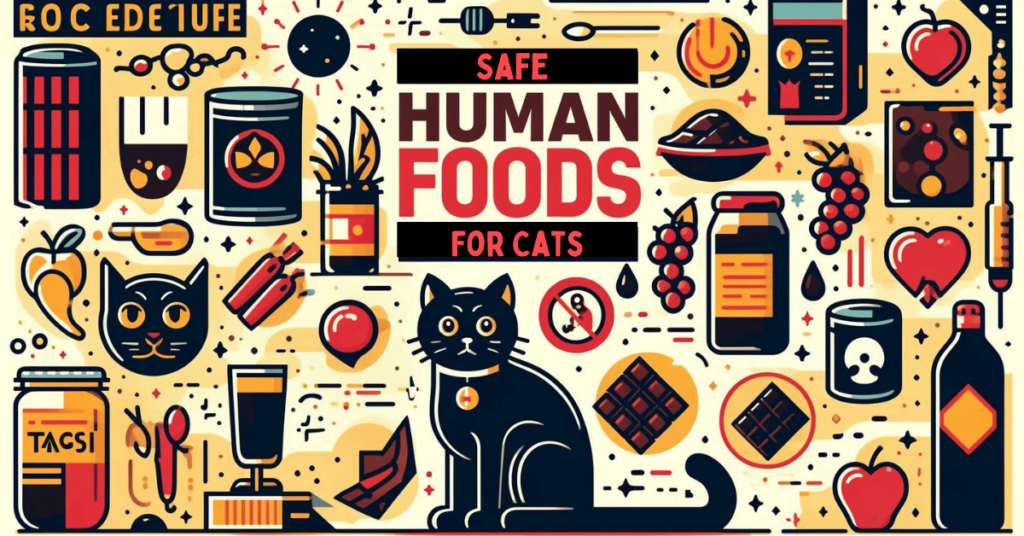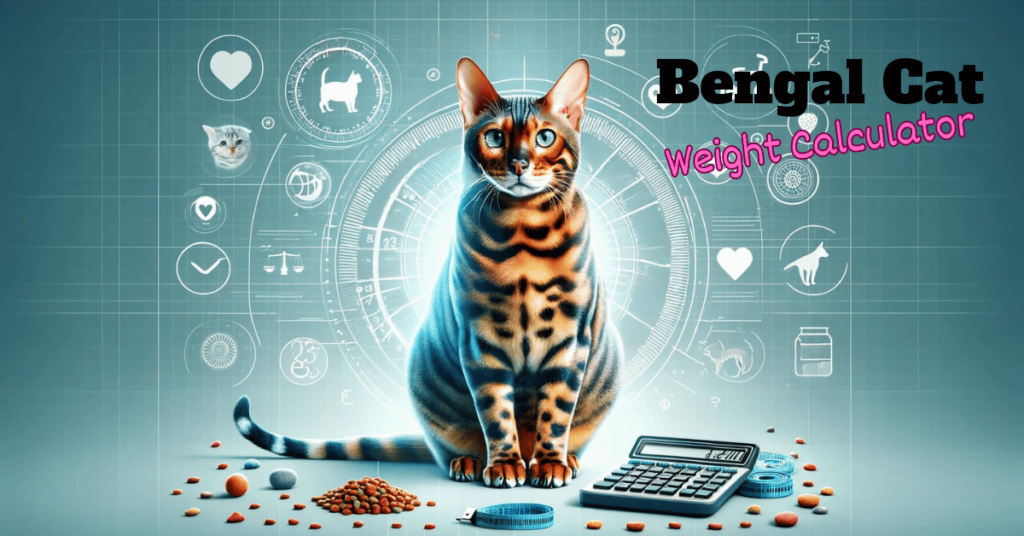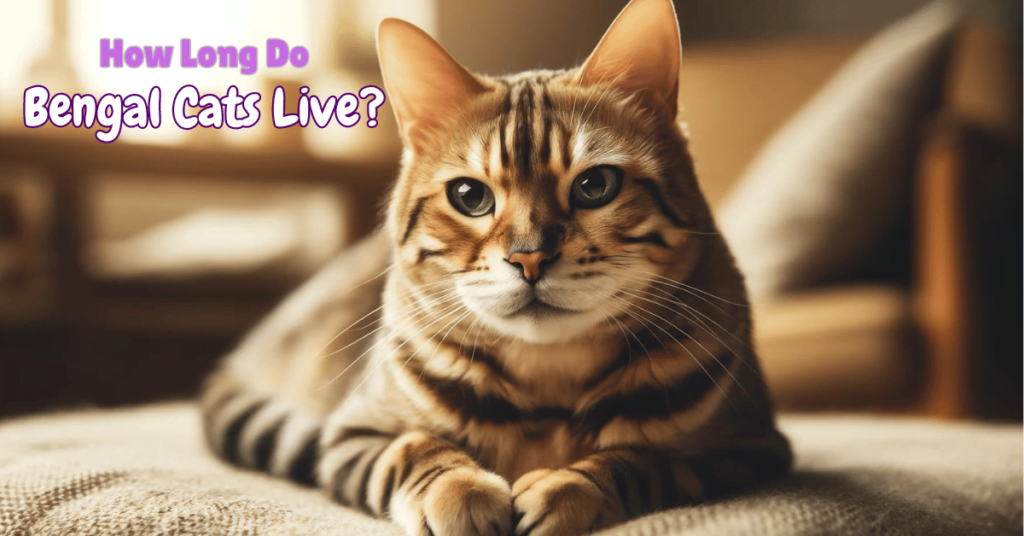This post contains affiliate links and I will be compensated if you make a purchase after clicking on my links.
Feeding Your Bengal Cat
Bengal cats are known for their striking appearance and boundless energy. With their high energy levels and sensitive stomachs, the diet you choose for your Bengal has to be nutritionally as close to nature as possible. Cats in the wild thrive on a diet rich in high-quality proteins, and understanding the biological value (BV) of various protein sources can help you replicate this natural diet at home.
A proper diet not only supports their health and well-being but also helps minimize behavioral and health issues. In this guide, we’ll explore how to feed a Bengal cat, focusing on high-quality protein sources that mimic their natural diet.
Understanding Bengal Cats’ Nutritional Needs

Bengal cats, like all felines, are obligate carnivores, meaning their diet in the wild consists almost entirely of meat. To replicate this natural diet, it’s essential to ensure that at least 50% of their food is high-quality protein. This is crucial for maintaining their muscle mass, energy levels, and overall health.
Key Nutrients for Bengal Cats
- Proteins: Bengal cats require a diet rich in animal-based proteins. Look for foods where the primary ingredient is meat or poultry.
- Fats: Healthy fats are vital for energy and coat health. Ensure the diet includes sources of omega-3 and omega-6 fatty acids.
- Vitamins and Minerals: Essential nutrients like taurine, vitamins A and D, and minerals such as calcium and phosphorus are crucial for your Bengal’s overall well-being.
Pro Tip: Cats, including Bengals, rarely drink enough water on their own. In the wild, their prey has a high water content, which helps keep them hydrated. To mimic this, incorporate food with a high water content into their diet or ensure their food has a high moisture content.
How to Feed a Bengal Cat
Let’s dive into the best feeding options for your Bengal, from raw diets to high-quality commercial foods.
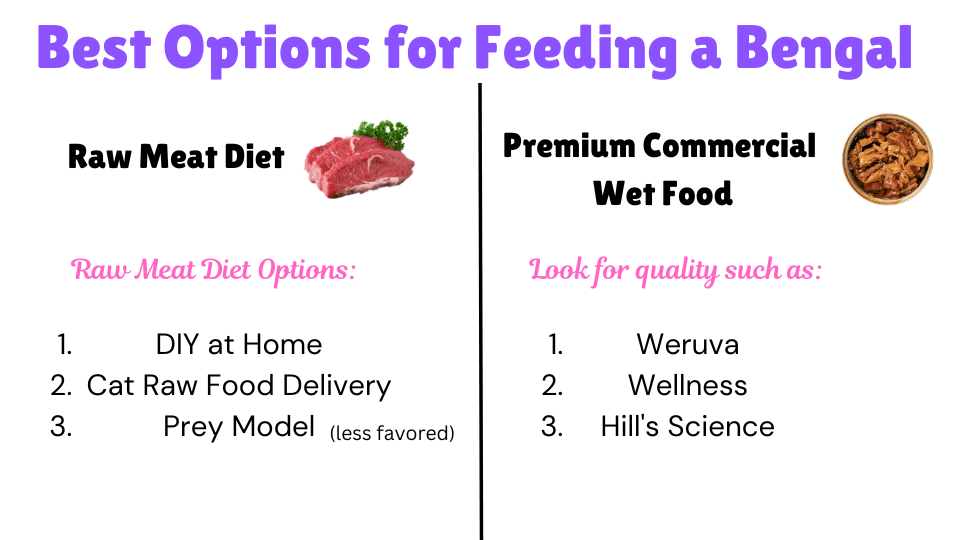
Raw Diet: The Ideal Choice for Bengal Cats
Preparing a raw diet for your Bengal cat can be time-consuming and messy, but it can save you money in the long run and significantly benefit your cat’s health. For Bengal cats, a raw diet can be the closest to their natural nutritional needs and can be highly beneficial. However, it requires careful preparation.
Fortunately, there are easier options, like buying pre-prepared raw food, which we explore in this section.
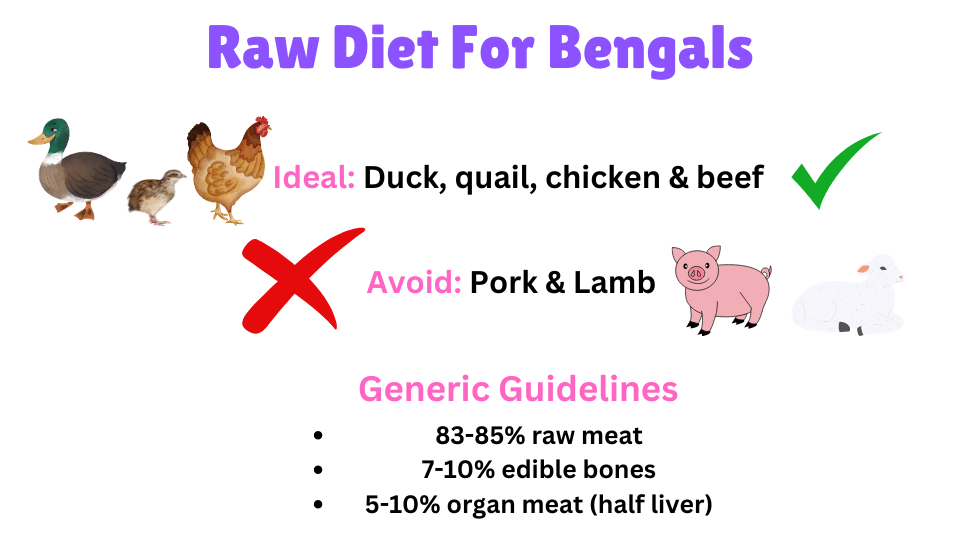
Types of Meat
Ideally, feed your Bengal chicken, duck, quail, rabbit or beef. However, chicken and smaller animals are preferable because Bengals are not naturally equipped to hunt and digest larger animals like cows. Their digestive systems lack the necessary enzymes to break down beef protein efficiently. Avoid pork and lamb entirely, as they are forbidden for cats.
Options for a Raw Meat Diet
Prepare Raw Food at Home
One approach is to make raw food at home. This requires finding a good recipe and using an industrial grinder to prepare the meat. You will also need to purchase various supplements to include in each batch to ensure it meets all your cat’s nutritional needs.
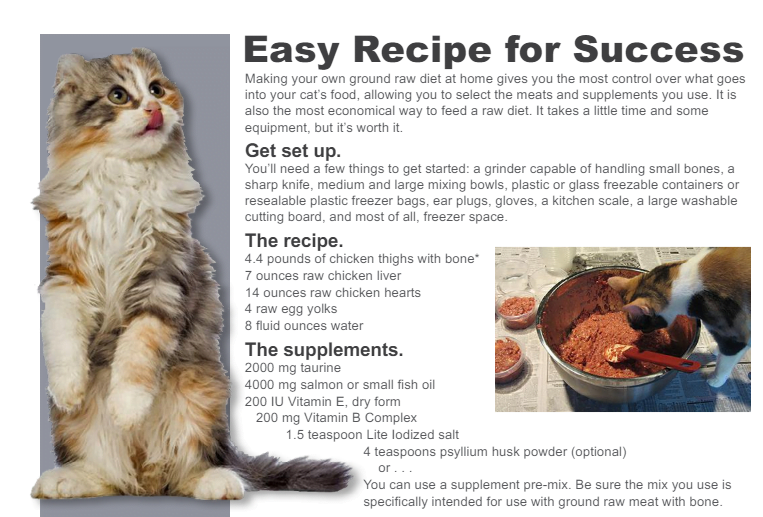
Buy Ready Raw Cat Food
An easier and less expensive option is to subscribe to a raw food delivery service. These services provide frozen raw cat food that you simply thaw and serve, making it a convenient way to ensure your Bengal gets all the benefits of a raw diet without the hassle of preparation. Just make sure the products are labeled as a complete diet, not just a supplemental treat.
Dehydrated raw food is another alternative. While it’s less fresh than frozen raw and just as expensive, it’s shelf-stable and only requires adding water. However, keep in mind that dehydrated raw foods are still highly processed and not the best option compared to frozen raw. They’re a convenient backup but not the top choice for optimal nutrition.
Serve Prey Model Raw
Another popular approach is the “prey model raw,” where instead of grinding, you feed your cat whole raw meat. This method mimics what cats would naturally hunt and eat in the wild, such as whole chickens, ducks, or rabbits. It involves providing the entire animal, including bones and organs, which supplies a more balanced and complete diet.
However, we don’t recommend buying raw meat from your butcher or grocery stores meant for human consumption and giving it directly to your cat. This can cause bacterial infections or other health issues.
If you do opt for meats from these sources, it’s safer to boil them first before feeding them to your cat, although this technically makes them no longer raw.
Fact: Cooking the meat destroys some enzymes and nutrients, so it’s ideal to feed raw—just like a cat would eat in the wild, without their human servants to serve them.
Basic Guidelines for Raw Feeding
- 83-85% raw meat
- 7-10% edible bones
- 5-10% organ meat (half of that being liver)
High-Quality Commercial Cat Food
If preparing a raw diet isn’t feasible, the next best option is premium high-quality commercial cat food, particularly wet food with occasional dry food. Keep in mind that adult Bengals might become ill if abruptly switched from natural food to commercial food, so transition gradually to avoid digestive issues. Here’s what to consider:
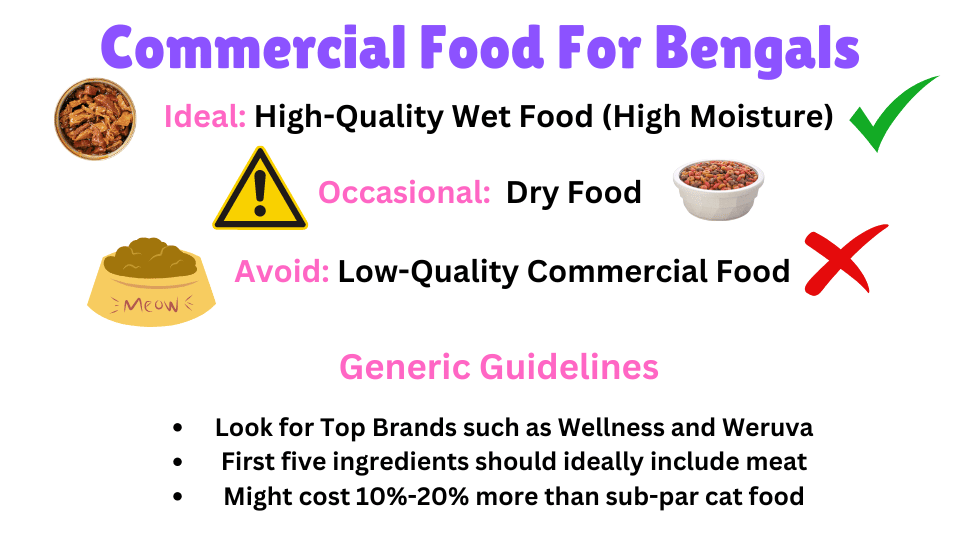
Best Type of Commercial Cat Food
Wet food is often preferable due to its higher moisture content, which helps keep your Bengal hydrated. Most Bengals will prefer wet food, especially if they are accustomed to it, and might skip the dry kibble.
While wet food is ideal for hydration, incorporating high-quality dry food into your Bengal’s diet occasionally can also be beneficial. Dry food (especially dental formulations) can help with dental health by reducing plaque buildup. If your Bengal enjoys dry food, you can include it in their diet without any issues.
Pro Tip: To strike a balance, you can mix dry food with wet food for a satisfying meal that provides both hydration and dental benefits. Many Bengals will love this combination.
Top Brands For Bengal Commercial Food
Look for brands like Weruva, Wellness, and Hill’s Science Diet. Ensure the first five ingredients are meat and avoid fillers like peas, corn, and soy. Quality food might be 10-20% more expensive, but it’s worth it because your Bengal cat gets all the essential nutrients they need for optimal health.
Treats and Supplements for Bengal Cats
As your Bengal cat grows into adulthood, their curiosity will lead them to want to try human food. While it’s okay to offer small amounts as a treat, human food should never make up a significant part of their diet.
Treats, including any human food, should comprise no more than 10% of their total diet. Here’s how to handle treats and supplements:
- Healthy Treat Options: Choose natural, meat-based treats without artificial additives. These are closer to what your Bengal would naturally eat and provide better nutritional benefits.
- Supplements: Supplements can be an important part of your Bengal’s diet, especially if they’re on a homemade or raw diet. Essential supplements might include taurine and omega fatty acids, which support heart health and a shiny coat.
- Human Food as Treats: When offering human food, be mindful of what’s safe for cats. Avoid toxic foods such as onions, garlic, and others that can harm your Bengal. Always research and verify the safety of any human food before giving it to your cat.
Pro Tip: Just like humans, Bengal cats can get bored with the same food every day. To keep your Bengal engaged and satisfied, rotate their food regularly. This not only prevents boredom but also ensures they receive a variety of nutrients.
How Often to Feed a Bengal Cat
Feeding your Bengal cat the right amount at the right times is crucial for their health and well-being. Bengal cats have unique nutritional needs that vary with their age and activity level. Here’s a breakdown of feeding schedules for kittens, adults, and seniors:
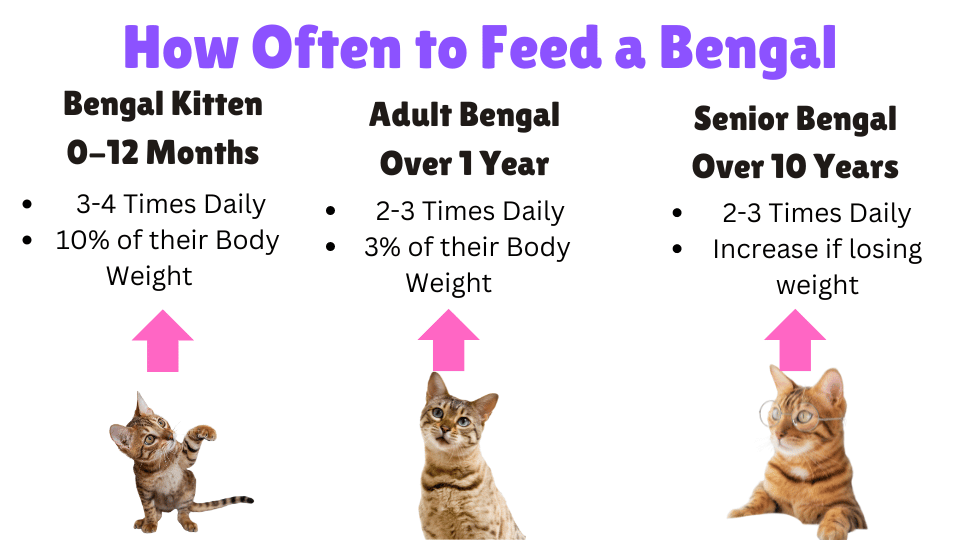
Kitten Feeding Schedule (0-12 months)
Bengal kittens require a specific feeding schedule to ensure they receive the necessary nutrients for optimal growth and health. Their fast metabolisms mean they need frequent meals as follows:
- Feed 3-4 times a day, as their metabolisms are very fast at this age.
- Divide the total daily feeding amount into these meals to prevent overeating or under-eating.
- The portion size for kittens can be twice or more the percentage of body weight compared to adults. However, it should not exceed 10% of their body weight, ensuring they get enough to support their rapid growth.
Adult Bengal Cat Feeding Schedule (Over 1 year)
Once your Bengal cat reaches adulthood, their feeding needs change. Here’s how to manage their diet:
- Feed 2-3 times a day, depending on their activity level.
- Start with the middle of the recommended range, which is about 3% of their ideal body weight, and adjust based on their weight and appetite.
- Keep a close eye on their weight and energy levels, and adjust the food quantity accordingly. Active Bengals may require a bit more food to maintain their energy levels, so don’t hesitate to increase their portions by about 10% if needed.
Senior Bengal Cat Feeding Schedule
As Bengals age, their dietary needs evolve. Older cats may need adjustments in their feeding schedule and diet to stay healthy.
- Feed 2-3 times a day, similar to adults, but pay closer attention to their specific needs.
- Adjust the diet to include more easily digestible foods and possibly more frequent, smaller meals to accommodate any changes in digestion and metabolism.
- Senior and elderly Bengal cats need more calories per pound of body weight to stay healthy. If your senior Bengal (above 10 years), starts losing muscle mass, it’s time to boost their calorie intake to 30 to 40 calories per pound.
Fact: It is normal for senior cats to lose or gain a bit of weight; typically, a fluctuation of one pound either way is not a cause for concern.
Wrapping Up: How to Feed a Bengal Cat Properly
Feeding your Bengal cat the right food in the right amounts is essential for their health and happiness. A high-quality, meat-based diet that closely mimics their natural prey is ideal. Consider raw diets or premium commercial cat foods, with a focus on foods with high water content for proper hydration.
Remember, the quality of the food is crucial, but so is the quantity, which needs to change over time based on age, activity level, and other factors like spaying, which can reduce their activity levels and require less food.
For personalized dietary advice, always consult with a veterinarian. They can help tailor a feeding plan specific to your Bengal cat’s needs.
Meet Sean, a fintech whiz with a penchant for pet purrs and blockchain buzz. After a decade of fintech feats, Sean’s tech talents leaped from ledger lines to litter lines, driven by a passion for pets and a vision for a more connected pet care community. With three critter companions as co-pilots, Sean launched this blog to share a treasury of pet-friendly tech tips and tales.


